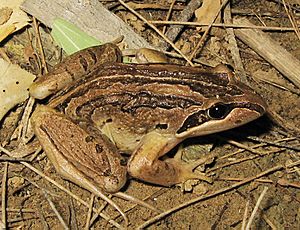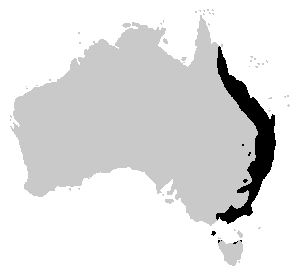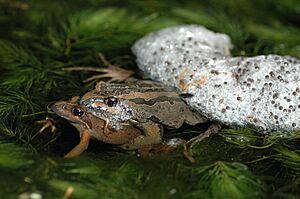Striped marsh frog facts for kids
Quick facts for kids Striped marsh frog |
|
|---|---|
 |
|
| Conservation status | |
| Scientific classification | |
 |
|
| Striped marsh frog range | |
| Synonyms | |
|
Cystignathus peronii (Dumeril & Bibron 1841) Limnodynastes krefftii Gunther 1863 |
The striped marsh frog (Limnodynastes peronii) is also called the brown-striped frog. This frog mostly lives in water. It is found along the coast of Eastern Australia. You can often see this common frog in cities and towns.
Contents
What is a Striped Marsh Frog?
The striped marsh frog is a type of frog known for its distinct stripes. French scientists André Marie Constant Duméril and Gabriel Bibron first described this frog in 1841.
How to Identify a Striped Marsh Frog
These frogs have a special look. Female frogs can grow up to about 7.5 centimeters (3 inches) long. Males are a bit smaller, reaching about 7 centimeters (2.7 inches).
Their skin is usually brown. It can be light brown, dark brown, or even a reddish-brown color. They have clear, darker stripes running down their back. This is how they got their name! Often, there's also a lighter stripe right down the middle of their back.
A black "mask" goes from their nose, through their eye, and down to their shoulder. Below this mask, there's a thick, shiny golden line that ends at the corner of their mouth. Male frogs have strong, thick arms. They use these arms to "wrestle" with other males. The throat of a male frog is yellow, and their belly is white.
Where Do Striped Marsh Frogs Live?
These frogs live in many places in Australia. You can find them from the southern part of the Cape York Peninsula in North Queensland. They also live all along the coast of New South Wales. Their home extends into Southern Victoria and southeastern South Australia. You can even find them in Northern Tasmania.
While they are very common in coastal New South Wales, they are not seen as often in Tasmania. In Tasmania, they are considered rare.
Striped Marsh Frog Habitat
The striped marsh frog is one of the most common frogs on Australia's east coast. They are often the first frogs to move into a garden pond. Sometimes, they even end up in backyard swimming pools!
They can live in many different wet places. This includes ponds, ditches by the road, creeks, and dams. They also like flooded areas and any other water body they can find. These frogs can even live in water that is a bit dirty or polluted.
Striped Marsh Frog Behavior and Life Cycle
Male striped marsh frogs call out while floating in the water. They hide among plants. Their call sounds like a "knock," like hitting wood with a hammer. You can hear them calling all year, but especially from spring to autumn. If you live in Sydney and have a garden pond, you probably know this sound well!
Reproduction and Tadpoles
The breeding season for these frogs is from late winter to early spring. Female frogs lay their eggs in a foamy nest. This foam helps protect the eggs. The tadpoles, which are baby frogs, can take a long time to grow. It can take 8 to 12 months for them to develop into frogs. These tadpoles are usually pale brown and can grow up to 6.5 centimeters (2.5 inches) long.
Keeping Striped Marsh Frogs as Pets
Some people keep striped marsh frogs as pets. In Australia, you need a special permit to keep this animal in captivity.
See also
 In Spanish: Limnodynastes peronii para niños
In Spanish: Limnodynastes peronii para niños



